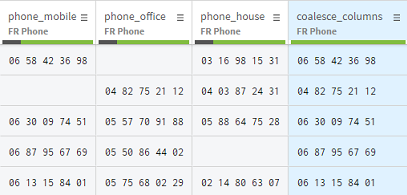Retrieving the first non empty value of several columns
With the Coalesce columns function, you can easily retrieve the first non null value across different columns to consolidate their data into a new column.
In this example, you are working on a dataset that contains information about your customers, including the different phone numbers at which you can reach them: office, mobile or home number. You can notice that some values are empty. Because you do not necessarily need to have 3 columns with similar information in your dataset, you can choose to create a new one containing only one phone number for each row, and make sure that the empty values are replaced with usable information at the same time. Here, you want to prioritize the mobile phone numbers, and retrieve the office or home number as backup.

Procedure
Results

Did this page help you?
If you find any issues with this page or its content – a typo, a missing step, or a technical error – let us know how we can improve!

